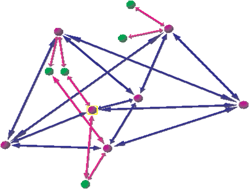Dynamic network topology changes in functional modules predict responses to oxidative stress in yeast†
Abstract
In response to environmental challenges, biological systems respond with dynamic adaptive changes in order to maintain the functionality of the system. Such adaptations may lead to cumulative stress over time, possibly leading to global failure of the system. When studying such systems responses, it is therefore important to understand them in system-wide and dynamic context. Here we hypothesize that dynamic changes in the topology of functional modules of integrated biological networks reflect their activity under specific environmental challenges. We introduce topological enrichment analysis of functional subnetworks (TEAFS), a method for the analysis of integrated molecular profile and interactome data, which we validated by comprehensive metabolomic analysis of dynamic yeast response under oxidative stress. TEAFS identified activation of multiple stress response related mechanisms, such as


 Please wait while we load your content...
Please wait while we load your content...